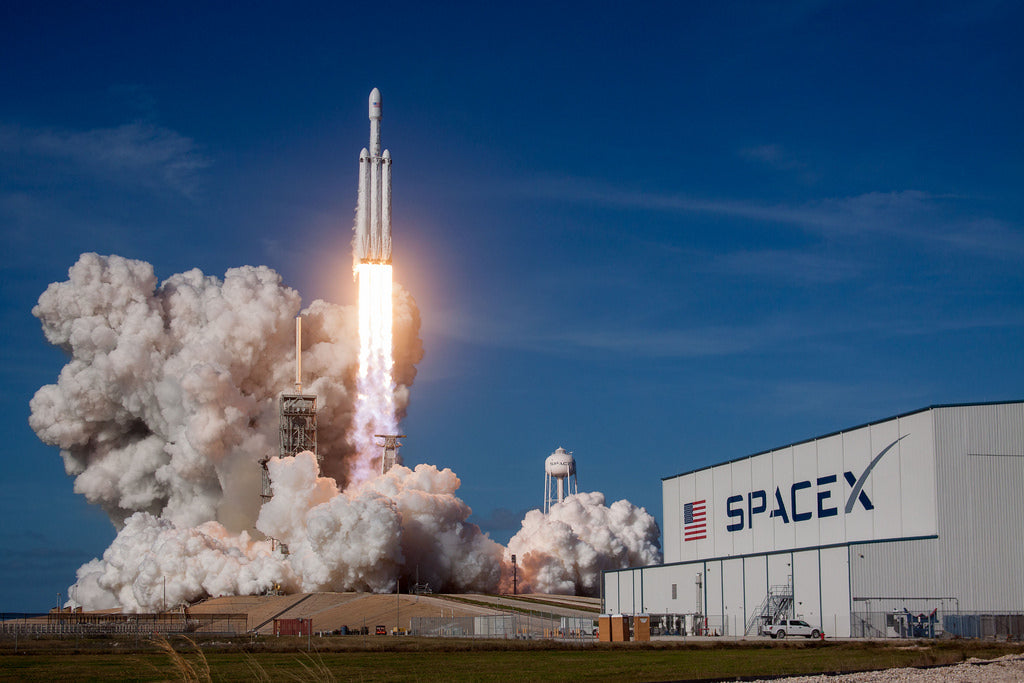So, in an effort to pull myself back from writing too much about astronomy, I wrote about biology for my last post. I had aspirations to do the same for this week. Then Elon Musk threw my aspirations in the trash and shook up the world of space travel (again).
On February 6, SpaceX launched its Falcon Heavy rocket for the first time. The rocket’s test launch went nearly perfectly. Its first-stage boosters worked without a hitch, landing safely almost simultaneously in Cape Canaveral. The second-stage core booster successfully launched its payload, a red Tesla Roadster “driven” by a spacesuit-clad mannequin. This core booster, however, missed its mark on a drone-ship in the Atlantic, crashing into the water at 300mph and damaging the drone-ship. Despite this hiccup, though, the launch was an overwhelming success.
Watch the launch here:
Click to view some stunning photos from the launch.
This rocket is groundbreaking in multiple ways and is the largest and strongest rocket currently in existence. The only rocket that ever had more payload carrying capabilities was the Saturn V moon rocket, but that hasn’t flown since 1973 and almost certainly never will again. The Delta IV Heavy, made by United Launch Alliance, is the former holder of the “Strongest Modern Rocket” title, which now belongs to the Falcon Heavy. Look at the table below to compare the three rockets.

(Statistics compiled by CNN Money. Click to see the stats of other impressive rockets throughout the ages.)
The Falcon Heavy is weaker and smaller than the Saturn V. So, what makes the success of the Falcon Heavy so exciting?
Well, for one, it is the strongest in operation today, and the Saturn V will never be produced again. The crew behind the Saturn V is no longer alive or working, and neither its components nor the tools used to make it exist any longer.
The two rockets also have/had totally different goals. The Saturn V was made for a government-funded agency (NASA) with the sole purpose of launching the Apollo missions to the moon (and eventually launching Skylab as its final payload in 1973). The Falcon Heavy, on the other hand, was made by a privately-funded company (SpaceX) to carry out a variety of mission-types for multiple customers. This shift from government-only space travel towards a playing field where companies compete with governments and each other for space innovation is incredibly promising for the future.
Perhaps the most exciting difference between the two, however, is the cost-effectiveness of the Falcon Heavy. NASA effectively paid no attention to costs when creating the Saturn V, coming in at a whooping $1.16 billion. This gargantuan sum was the result of an unyielding desire by the US to beat the USSR to the moon in the space race as a part of the larger Cold War. The Falcon Heavy, on the other hand, is much, much cheaper at only $90 million. This dramatically lower cost is due in part to the reusability of the the rocket cores. By having reusable rockets, SpaceX is massively cutting down on the prohibitively high costs of getting something off this planet.
Read a more complete comparison between the rockets here.
Elon Musk's intentions with SpaceX are clear. As Business Insider reported from the post-launch press conference, Musk said:
"We want a new space race. Space races are exciting [...] I think it's going to encourage other companies and countries to say, 'Hey, if SpaceX, which is a commercial company, and it can do this, and nobody paid for Falcon Heavy, it was paid with internal funds,' then they could do it, too [...] So I think it's going to encourage other countries and companies to raise their sights and say, 'We can do bigger and better,' which is great."
So what are SpaceX's plans after unveiling their mega-powerful, reusable, general-purpose, game-changing rocket? Well, they're obviously going to discontinue it almost immediately. Back in September, Musk announced his plans to have the company's next project, code named "BFR," take over the company's focus as an essential part of his Mars colonization effort. This multipurpose craft will be stronger and larger than the Falcon Heavy, and come in several variants – a tanker for mid-orbit refueling, a satellite delivery craft, and a spaceship for transporting people and cargo between planets, continents, and through Low Earth Orbit.
I am especially excited about the mid-orbit refueling tanker. Since rockets burn most of their fuel when leaving Earth, long-distance space travel practically requires refueling in orbit, away from such a strong gravitational field.
The BFR is, against all odds, even more promising intriguing than the success we saw on Tuesday with the Falcon Heavy. Though the phase out of their other projects might seem premature, SpaceX is planning on having plenty of their Falcon rockets and Dragon spacecrafts on standby for their customers to use while the BFR proves itself. This phase out will simply cut costs further in the development of the infrastructure for their master plan – making humans a multiplanetary species.
With all of this said, I am more than excited. I, as a younger person who loves space, missed out on the first space race and the intense public interest in space brought about by the cold war. With Elon Musk and SpaceX, the dream of a new space race is being brought back to life, this time without the baggage and terror of intense geopolitics in the mix. My mind is racing with the thought that in my 30s or 40s I could be watching a human on my TV make the first footsteps on the soil of another planet.
What are your thoughts on the Falcon Heavy launch, SpaceX, or private space travel as a whole? Share them in the comments if you'd like!
Written By: Jacob Monash












1 comment
Jessi Brawley
It really was an incredible thing to see! I agree that it was worthy of talk!!